HR Report: Analyzing Different Employment Contracts and Their Impact
VerifiedAdded on 2023/01/05
|11
|3321
|48
Report
AI Summary
This report delves into the intricacies of employment contracts, comparing and contrasting various types including full-time, permanent part-time, zero-hour, and fixed-term contracts. The analysis covers the advantages and disadvantages of each contract type from both the employee and employer perspectives, considering factors such as benefits, job security, flexibility, and cost. The report also examines real-world examples from companies like ASDA and TESCO, illustrating how different contractual methods are used in practice and the rationale behind these choices. Furthermore, it discusses the legal aspects of employment contracts, including employee rights, employer responsibilities, and the importance of clear agreements to prevent disputes. The report highlights the significance of contracts in ensuring smooth business operations and protecting the interests of both parties involved, emphasizing the role of contractual terms in fostering positive working relationships and compliance with labor laws.
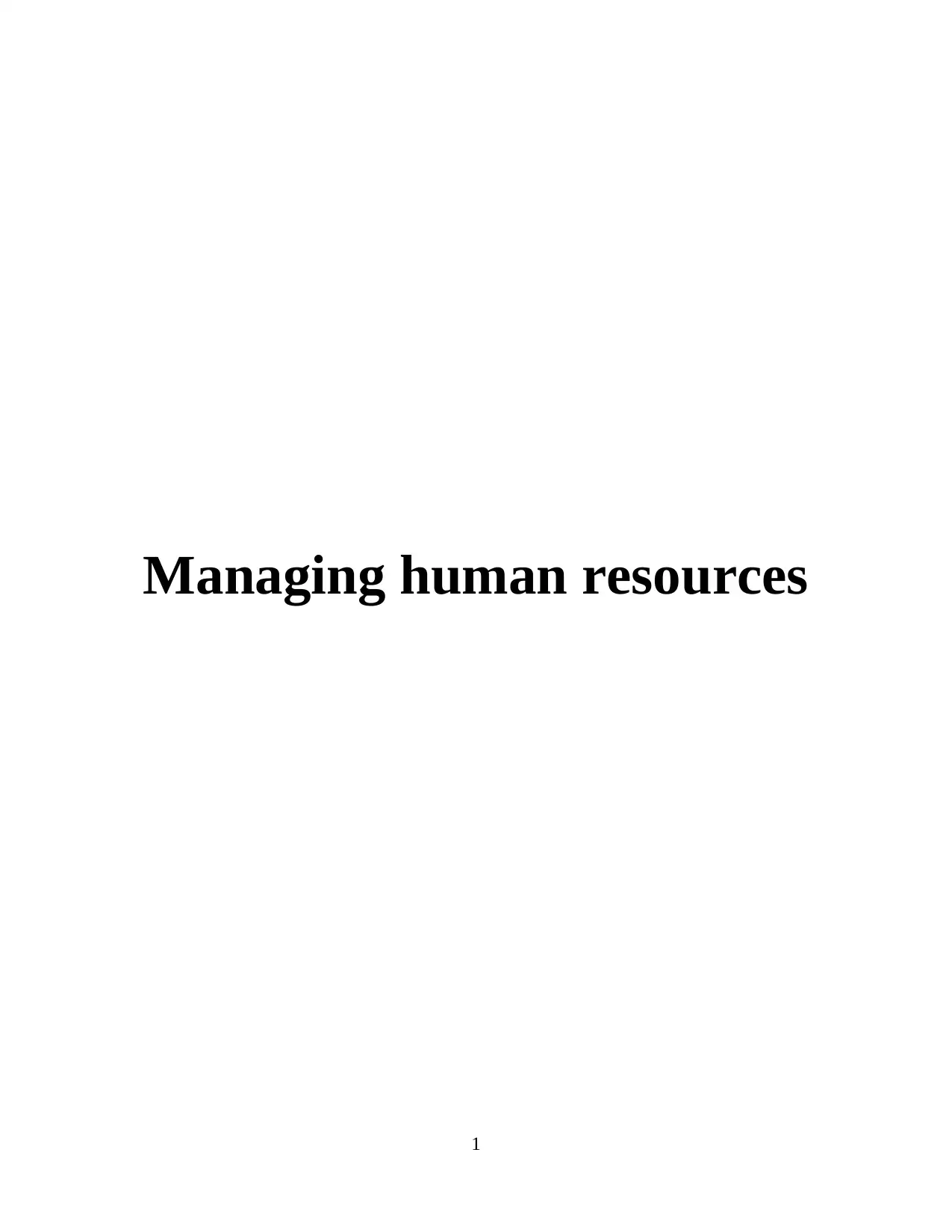
Managing human resources
1
1
Paraphrase This Document
Need a fresh take? Get an instant paraphrase of this document with our AI Paraphraser
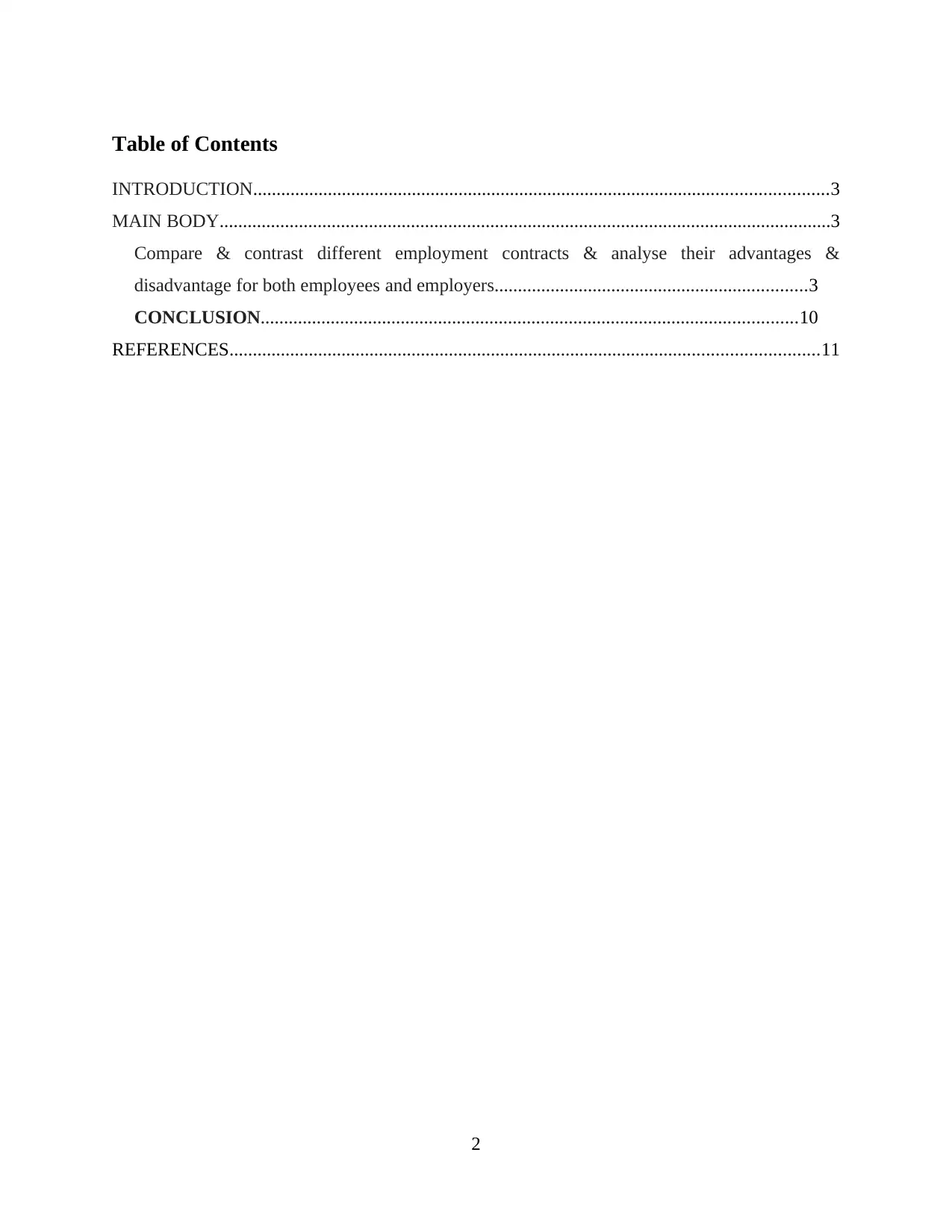
Table of Contents
INTRODUCTION...........................................................................................................................3
MAIN BODY...................................................................................................................................3
Compare & contrast different employment contracts & analyse their advantages &
disadvantage for both employees and employers...................................................................3
CONCLUSION...................................................................................................................10
REFERENCES..............................................................................................................................11
2
INTRODUCTION...........................................................................................................................3
MAIN BODY...................................................................................................................................3
Compare & contrast different employment contracts & analyse their advantages &
disadvantage for both employees and employers...................................................................3
CONCLUSION...................................................................................................................10
REFERENCES..............................................................................................................................11
2
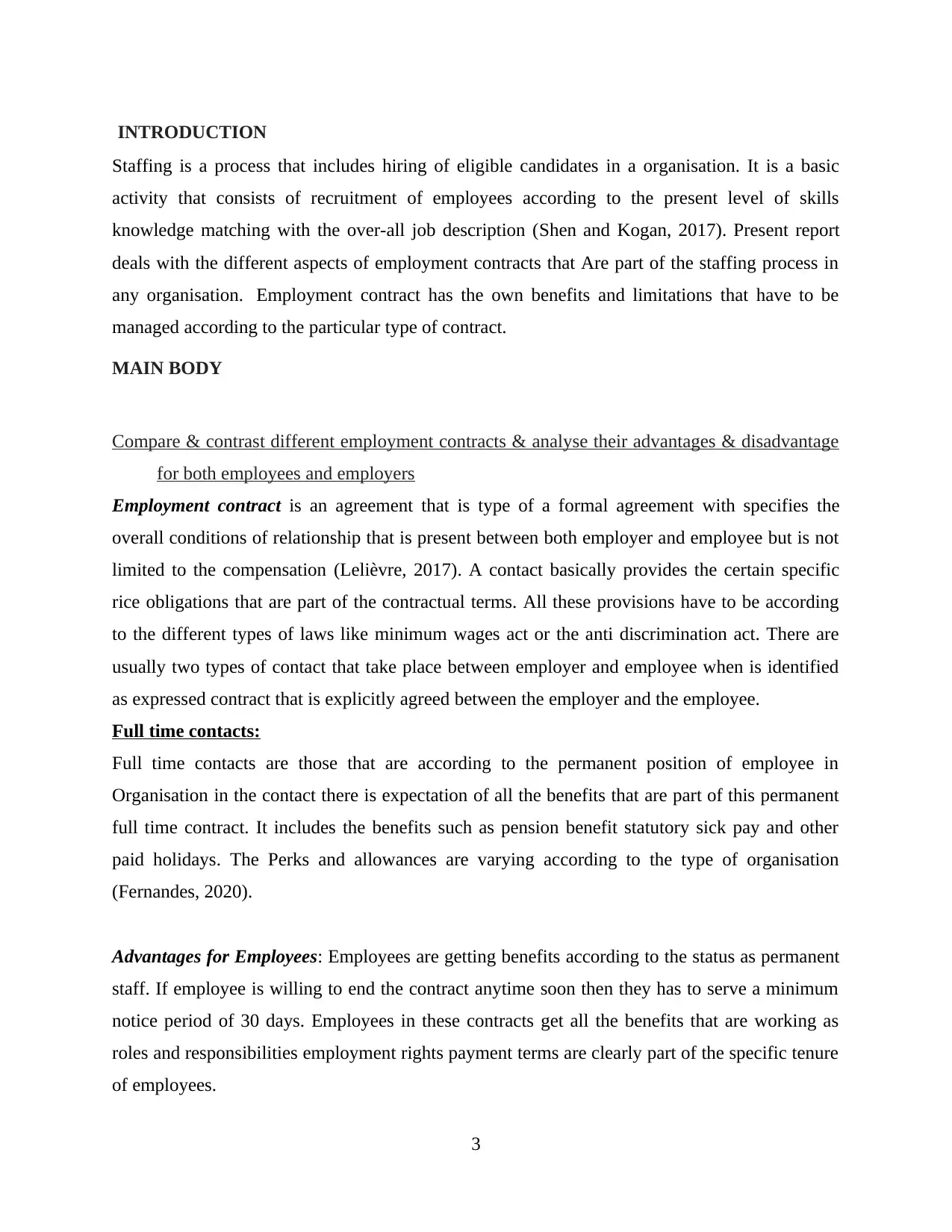
INTRODUCTION
Staffing is a process that includes hiring of eligible candidates in a organisation. It is a basic
activity that consists of recruitment of employees according to the present level of skills
knowledge matching with the over-all job description (Shen and Kogan, 2017). Present report
deals with the different aspects of employment contracts that Are part of the staffing process in
any organisation. Employment contract has the own benefits and limitations that have to be
managed according to the particular type of contract.
MAIN BODY
Compare & contrast different employment contracts & analyse their advantages & disadvantage
for both employees and employers
Employment contract is an agreement that is type of a formal agreement with specifies the
overall conditions of relationship that is present between both employer and employee but is not
limited to the compensation (Lelièvre, 2017). A contact basically provides the certain specific
rice obligations that are part of the contractual terms. All these provisions have to be according
to the different types of laws like minimum wages act or the anti discrimination act. There are
usually two types of contact that take place between employer and employee when is identified
as expressed contract that is explicitly agreed between the employer and the employee.
Full time contacts:
Full time contacts are those that are according to the permanent position of employee in
Organisation in the contact there is expectation of all the benefits that are part of this permanent
full time contract. It includes the benefits such as pension benefit statutory sick pay and other
paid holidays. The Perks and allowances are varying according to the type of organisation
(Fernandes, 2020).
Advantages for Employees: Employees are getting benefits according to the status as permanent
staff. If employee is willing to end the contract anytime soon then they has to serve a minimum
notice period of 30 days. Employees in these contracts get all the benefits that are working as
roles and responsibilities employment rights payment terms are clearly part of the specific tenure
of employees.
3
Staffing is a process that includes hiring of eligible candidates in a organisation. It is a basic
activity that consists of recruitment of employees according to the present level of skills
knowledge matching with the over-all job description (Shen and Kogan, 2017). Present report
deals with the different aspects of employment contracts that Are part of the staffing process in
any organisation. Employment contract has the own benefits and limitations that have to be
managed according to the particular type of contract.
MAIN BODY
Compare & contrast different employment contracts & analyse their advantages & disadvantage
for both employees and employers
Employment contract is an agreement that is type of a formal agreement with specifies the
overall conditions of relationship that is present between both employer and employee but is not
limited to the compensation (Lelièvre, 2017). A contact basically provides the certain specific
rice obligations that are part of the contractual terms. All these provisions have to be according
to the different types of laws like minimum wages act or the anti discrimination act. There are
usually two types of contact that take place between employer and employee when is identified
as expressed contract that is explicitly agreed between the employer and the employee.
Full time contacts:
Full time contacts are those that are according to the permanent position of employee in
Organisation in the contact there is expectation of all the benefits that are part of this permanent
full time contract. It includes the benefits such as pension benefit statutory sick pay and other
paid holidays. The Perks and allowances are varying according to the type of organisation
(Fernandes, 2020).
Advantages for Employees: Employees are getting benefits according to the status as permanent
staff. If employee is willing to end the contract anytime soon then they has to serve a minimum
notice period of 30 days. Employees in these contracts get all the benefits that are working as
roles and responsibilities employment rights payment terms are clearly part of the specific tenure
of employees.
3
⊘ This is a preview!⊘
Do you want full access?
Subscribe today to unlock all pages.

Trusted by 1+ million students worldwide
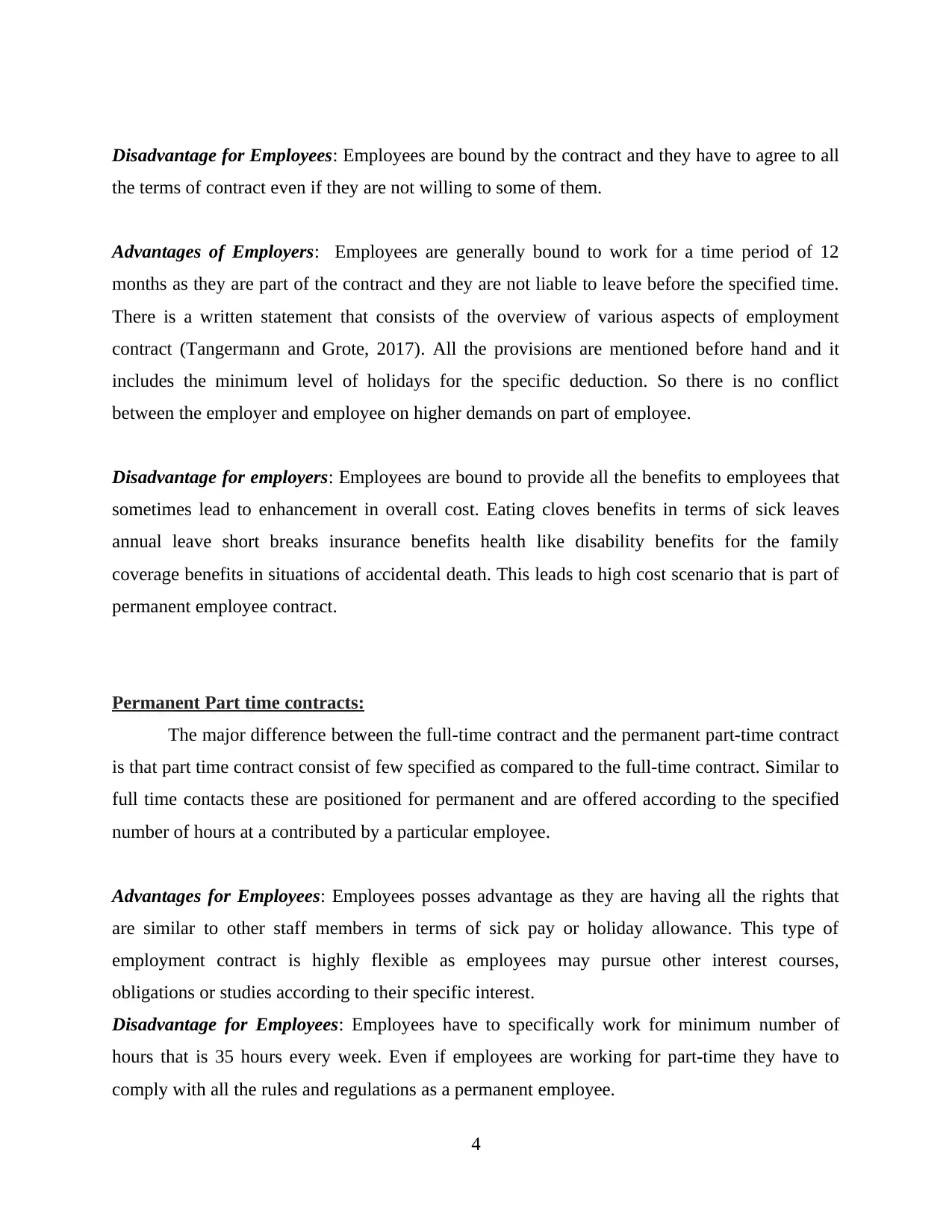
Disadvantage for Employees: Employees are bound by the contract and they have to agree to all
the terms of contract even if they are not willing to some of them.
Advantages of Employers: Employees are generally bound to work for a time period of 12
months as they are part of the contract and they are not liable to leave before the specified time.
There is a written statement that consists of the overview of various aspects of employment
contract (Tangermann and Grote, 2017). All the provisions are mentioned before hand and it
includes the minimum level of holidays for the specific deduction. So there is no conflict
between the employer and employee on higher demands on part of employee.
Disadvantage for employers: Employees are bound to provide all the benefits to employees that
sometimes lead to enhancement in overall cost. Eating cloves benefits in terms of sick leaves
annual leave short breaks insurance benefits health like disability benefits for the family
coverage benefits in situations of accidental death. This leads to high cost scenario that is part of
permanent employee contract.
Permanent Part time contracts:
The major difference between the full-time contract and the permanent part-time contract
is that part time contract consist of few specified as compared to the full-time contract. Similar to
full time contacts these are positioned for permanent and are offered according to the specified
number of hours at a contributed by a particular employee.
Advantages for Employees: Employees posses advantage as they are having all the rights that
are similar to other staff members in terms of sick pay or holiday allowance. This type of
employment contract is highly flexible as employees may pursue other interest courses,
obligations or studies according to their specific interest.
Disadvantage for Employees: Employees have to specifically work for minimum number of
hours that is 35 hours every week. Even if employees are working for part-time they have to
comply with all the rules and regulations as a permanent employee.
4
the terms of contract even if they are not willing to some of them.
Advantages of Employers: Employees are generally bound to work for a time period of 12
months as they are part of the contract and they are not liable to leave before the specified time.
There is a written statement that consists of the overview of various aspects of employment
contract (Tangermann and Grote, 2017). All the provisions are mentioned before hand and it
includes the minimum level of holidays for the specific deduction. So there is no conflict
between the employer and employee on higher demands on part of employee.
Disadvantage for employers: Employees are bound to provide all the benefits to employees that
sometimes lead to enhancement in overall cost. Eating cloves benefits in terms of sick leaves
annual leave short breaks insurance benefits health like disability benefits for the family
coverage benefits in situations of accidental death. This leads to high cost scenario that is part of
permanent employee contract.
Permanent Part time contracts:
The major difference between the full-time contract and the permanent part-time contract
is that part time contract consist of few specified as compared to the full-time contract. Similar to
full time contacts these are positioned for permanent and are offered according to the specified
number of hours at a contributed by a particular employee.
Advantages for Employees: Employees posses advantage as they are having all the rights that
are similar to other staff members in terms of sick pay or holiday allowance. This type of
employment contract is highly flexible as employees may pursue other interest courses,
obligations or studies according to their specific interest.
Disadvantage for Employees: Employees have to specifically work for minimum number of
hours that is 35 hours every week. Even if employees are working for part-time they have to
comply with all the rules and regulations as a permanent employee.
4
Paraphrase This Document
Need a fresh take? Get an instant paraphrase of this document with our AI Paraphraser
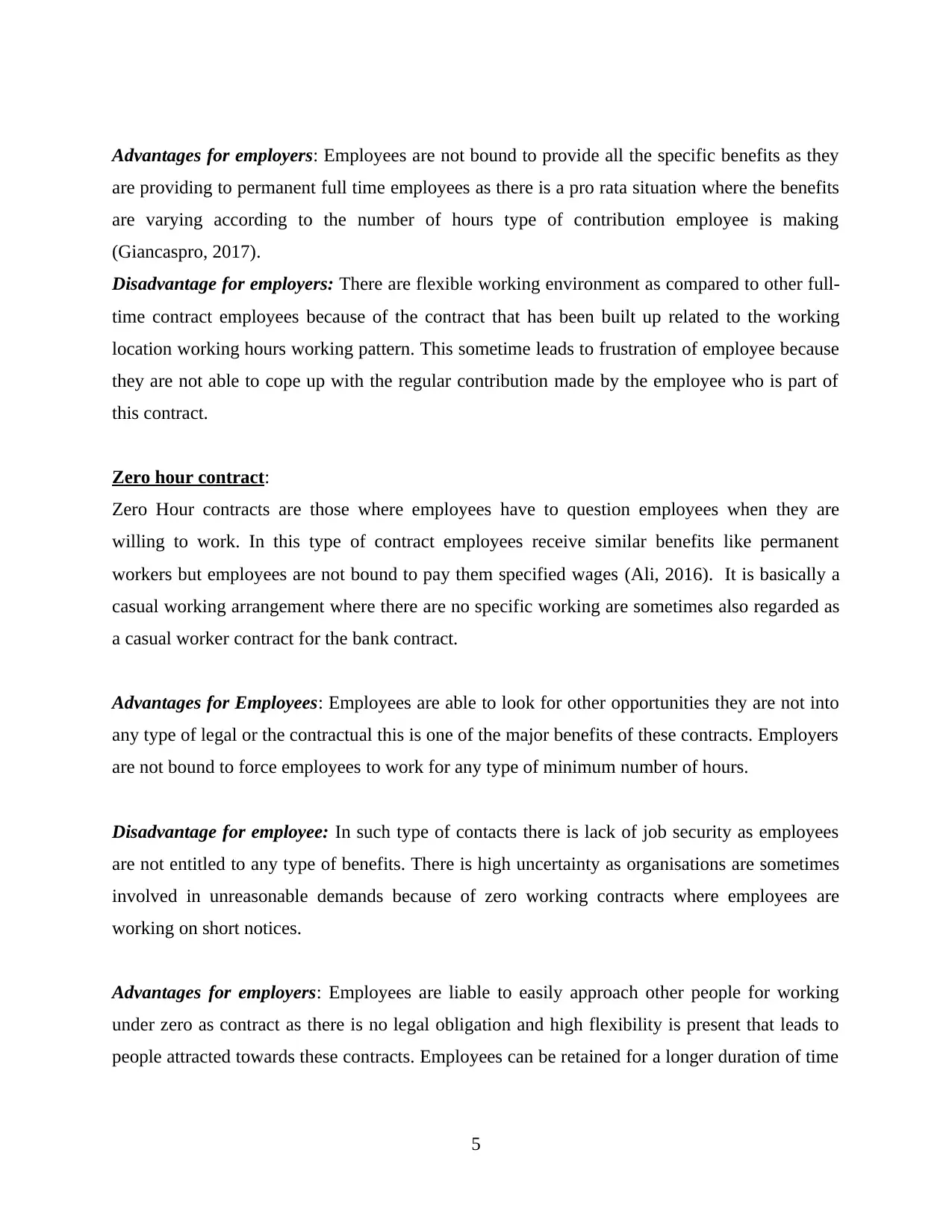
Advantages for employers: Employees are not bound to provide all the specific benefits as they
are providing to permanent full time employees as there is a pro rata situation where the benefits
are varying according to the number of hours type of contribution employee is making
(Giancaspro, 2017).
Disadvantage for employers: There are flexible working environment as compared to other full-
time contract employees because of the contract that has been built up related to the working
location working hours working pattern. This sometime leads to frustration of employee because
they are not able to cope up with the regular contribution made by the employee who is part of
this contract.
Zero hour contract:
Zero Hour contracts are those where employees have to question employees when they are
willing to work. In this type of contract employees receive similar benefits like permanent
workers but employees are not bound to pay them specified wages (Ali, 2016). It is basically a
casual working arrangement where there are no specific working are sometimes also regarded as
a casual worker contract for the bank contract.
Advantages for Employees: Employees are able to look for other opportunities they are not into
any type of legal or the contractual this is one of the major benefits of these contracts. Employers
are not bound to force employees to work for any type of minimum number of hours.
Disadvantage for employee: In such type of contacts there is lack of job security as employees
are not entitled to any type of benefits. There is high uncertainty as organisations are sometimes
involved in unreasonable demands because of zero working contracts where employees are
working on short notices.
Advantages for employers: Employees are liable to easily approach other people for working
under zero as contract as there is no legal obligation and high flexibility is present that leads to
people attracted towards these contracts. Employees can be retained for a longer duration of time
5
are providing to permanent full time employees as there is a pro rata situation where the benefits
are varying according to the number of hours type of contribution employee is making
(Giancaspro, 2017).
Disadvantage for employers: There are flexible working environment as compared to other full-
time contract employees because of the contract that has been built up related to the working
location working hours working pattern. This sometime leads to frustration of employee because
they are not able to cope up with the regular contribution made by the employee who is part of
this contract.
Zero hour contract:
Zero Hour contracts are those where employees have to question employees when they are
willing to work. In this type of contract employees receive similar benefits like permanent
workers but employees are not bound to pay them specified wages (Ali, 2016). It is basically a
casual working arrangement where there are no specific working are sometimes also regarded as
a casual worker contract for the bank contract.
Advantages for Employees: Employees are able to look for other opportunities they are not into
any type of legal or the contractual this is one of the major benefits of these contracts. Employers
are not bound to force employees to work for any type of minimum number of hours.
Disadvantage for employee: In such type of contacts there is lack of job security as employees
are not entitled to any type of benefits. There is high uncertainty as organisations are sometimes
involved in unreasonable demands because of zero working contracts where employees are
working on short notices.
Advantages for employers: Employees are liable to easily approach other people for working
under zero as contract as there is no legal obligation and high flexibility is present that leads to
people attracted towards these contracts. Employees can be retained for a longer duration of time
5
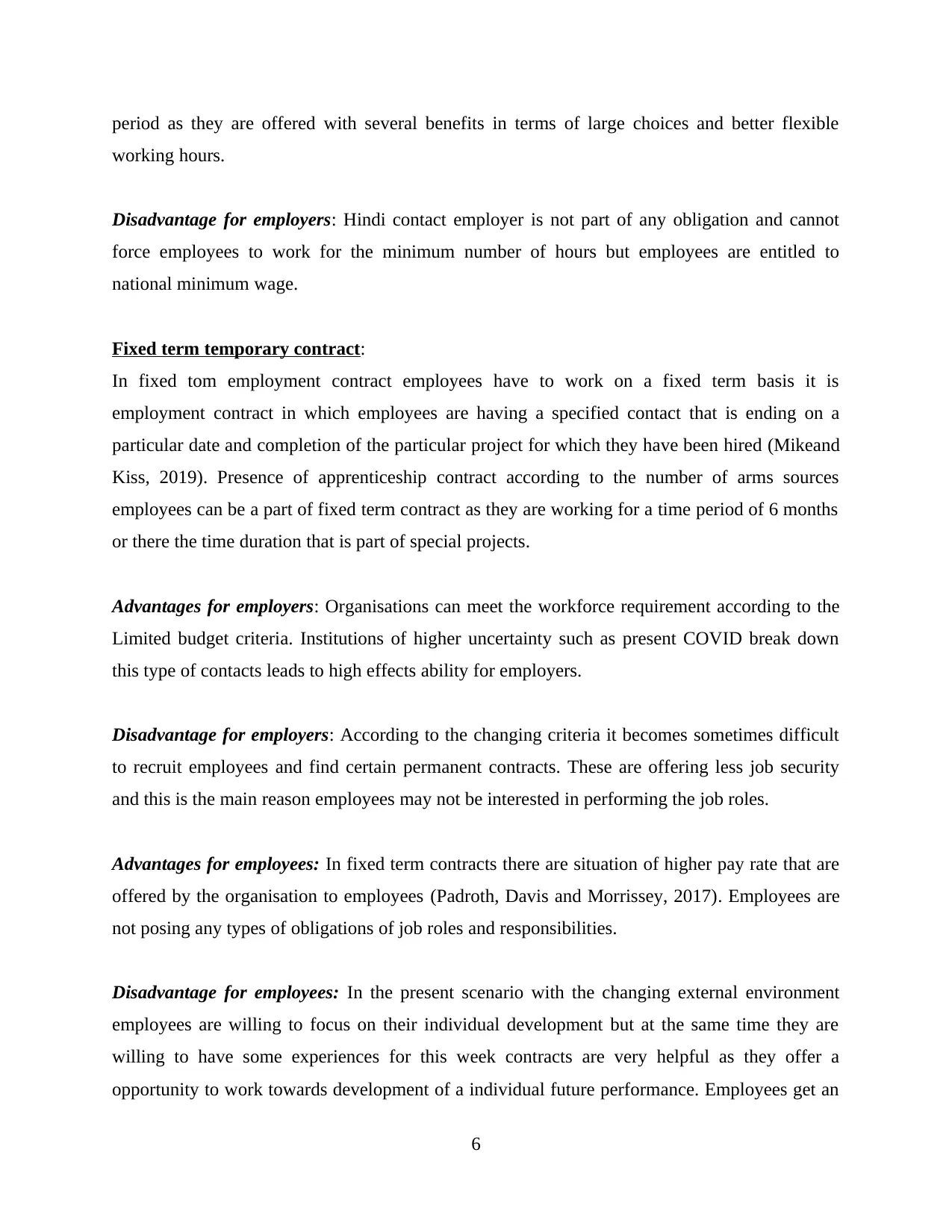
period as they are offered with several benefits in terms of large choices and better flexible
working hours.
Disadvantage for employers: Hindi contact employer is not part of any obligation and cannot
force employees to work for the minimum number of hours but employees are entitled to
national minimum wage.
Fixed term temporary contract:
In fixed tom employment contract employees have to work on a fixed term basis it is
employment contract in which employees are having a specified contact that is ending on a
particular date and completion of the particular project for which they have been hired (Mikeand
Kiss, 2019). Presence of apprenticeship contract according to the number of arms sources
employees can be a part of fixed term contract as they are working for a time period of 6 months
or there the time duration that is part of special projects.
Advantages for employers: Organisations can meet the workforce requirement according to the
Limited budget criteria. Institutions of higher uncertainty such as present COVID break down
this type of contacts leads to high effects ability for employers.
Disadvantage for employers: According to the changing criteria it becomes sometimes difficult
to recruit employees and find certain permanent contracts. These are offering less job security
and this is the main reason employees may not be interested in performing the job roles.
Advantages for employees: In fixed term contracts there are situation of higher pay rate that are
offered by the organisation to employees (Padroth, Davis and Morrissey, 2017). Employees are
not posing any types of obligations of job roles and responsibilities.
Disadvantage for employees: In the present scenario with the changing external environment
employees are willing to focus on their individual development but at the same time they are
willing to have some experiences for this week contracts are very helpful as they offer a
opportunity to work towards development of a individual future performance. Employees get an
6
working hours.
Disadvantage for employers: Hindi contact employer is not part of any obligation and cannot
force employees to work for the minimum number of hours but employees are entitled to
national minimum wage.
Fixed term temporary contract:
In fixed tom employment contract employees have to work on a fixed term basis it is
employment contract in which employees are having a specified contact that is ending on a
particular date and completion of the particular project for which they have been hired (Mikeand
Kiss, 2019). Presence of apprenticeship contract according to the number of arms sources
employees can be a part of fixed term contract as they are working for a time period of 6 months
or there the time duration that is part of special projects.
Advantages for employers: Organisations can meet the workforce requirement according to the
Limited budget criteria. Institutions of higher uncertainty such as present COVID break down
this type of contacts leads to high effects ability for employers.
Disadvantage for employers: According to the changing criteria it becomes sometimes difficult
to recruit employees and find certain permanent contracts. These are offering less job security
and this is the main reason employees may not be interested in performing the job roles.
Advantages for employees: In fixed term contracts there are situation of higher pay rate that are
offered by the organisation to employees (Padroth, Davis and Morrissey, 2017). Employees are
not posing any types of obligations of job roles and responsibilities.
Disadvantage for employees: In the present scenario with the changing external environment
employees are willing to focus on their individual development but at the same time they are
willing to have some experiences for this week contracts are very helpful as they offer a
opportunity to work towards development of a individual future performance. Employees get an
6
⊘ This is a preview!⊘
Do you want full access?
Subscribe today to unlock all pages.

Trusted by 1+ million students worldwide
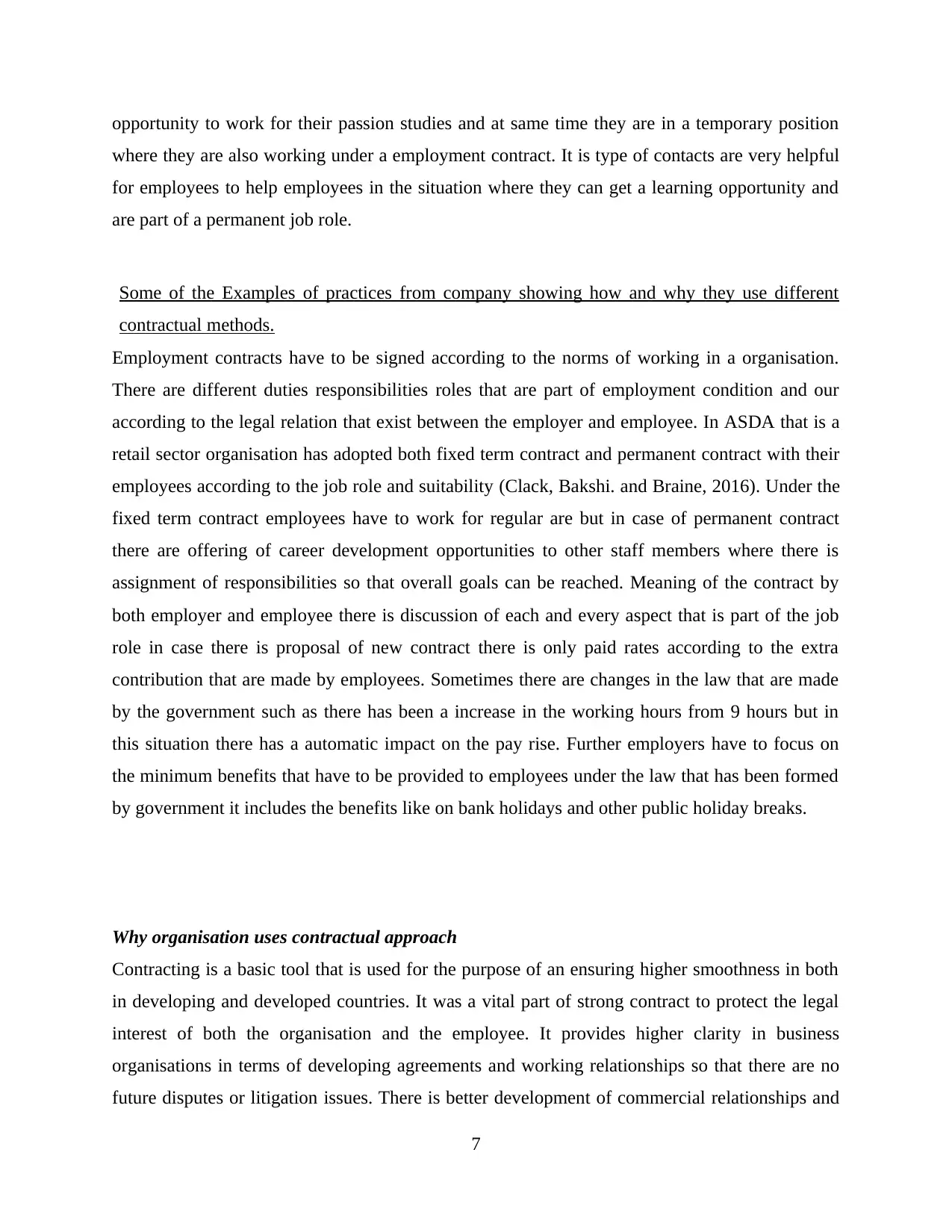
opportunity to work for their passion studies and at same time they are in a temporary position
where they are also working under a employment contract. It is type of contacts are very helpful
for employees to help employees in the situation where they can get a learning opportunity and
are part of a permanent job role.
Some of the Examples of practices from company showing how and why they use different
contractual methods.
Employment contracts have to be signed according to the norms of working in a organisation.
There are different duties responsibilities roles that are part of employment condition and our
according to the legal relation that exist between the employer and employee. In ASDA that is a
retail sector organisation has adopted both fixed term contract and permanent contract with their
employees according to the job role and suitability (Clack, Bakshi. and Braine, 2016). Under the
fixed term contract employees have to work for regular are but in case of permanent contract
there are offering of career development opportunities to other staff members where there is
assignment of responsibilities so that overall goals can be reached. Meaning of the contract by
both employer and employee there is discussion of each and every aspect that is part of the job
role in case there is proposal of new contract there is only paid rates according to the extra
contribution that are made by employees. Sometimes there are changes in the law that are made
by the government such as there has been a increase in the working hours from 9 hours but in
this situation there has a automatic impact on the pay rise. Further employers have to focus on
the minimum benefits that have to be provided to employees under the law that has been formed
by government it includes the benefits like on bank holidays and other public holiday breaks.
Why organisation uses contractual approach
Contracting is a basic tool that is used for the purpose of an ensuring higher smoothness in both
in developing and developed countries. It was a vital part of strong contract to protect the legal
interest of both the organisation and the employee. It provides higher clarity in business
organisations in terms of developing agreements and working relationships so that there are no
future disputes or litigation issues. There is better development of commercial relationships and
7
where they are also working under a employment contract. It is type of contacts are very helpful
for employees to help employees in the situation where they can get a learning opportunity and
are part of a permanent job role.
Some of the Examples of practices from company showing how and why they use different
contractual methods.
Employment contracts have to be signed according to the norms of working in a organisation.
There are different duties responsibilities roles that are part of employment condition and our
according to the legal relation that exist between the employer and employee. In ASDA that is a
retail sector organisation has adopted both fixed term contract and permanent contract with their
employees according to the job role and suitability (Clack, Bakshi. and Braine, 2016). Under the
fixed term contract employees have to work for regular are but in case of permanent contract
there are offering of career development opportunities to other staff members where there is
assignment of responsibilities so that overall goals can be reached. Meaning of the contract by
both employer and employee there is discussion of each and every aspect that is part of the job
role in case there is proposal of new contract there is only paid rates according to the extra
contribution that are made by employees. Sometimes there are changes in the law that are made
by the government such as there has been a increase in the working hours from 9 hours but in
this situation there has a automatic impact on the pay rise. Further employers have to focus on
the minimum benefits that have to be provided to employees under the law that has been formed
by government it includes the benefits like on bank holidays and other public holiday breaks.
Why organisation uses contractual approach
Contracting is a basic tool that is used for the purpose of an ensuring higher smoothness in both
in developing and developed countries. It was a vital part of strong contract to protect the legal
interest of both the organisation and the employee. It provides higher clarity in business
organisations in terms of developing agreements and working relationships so that there are no
future disputes or litigation issues. There is better development of commercial relationships and
7
Paraphrase This Document
Need a fresh take? Get an instant paraphrase of this document with our AI Paraphraser
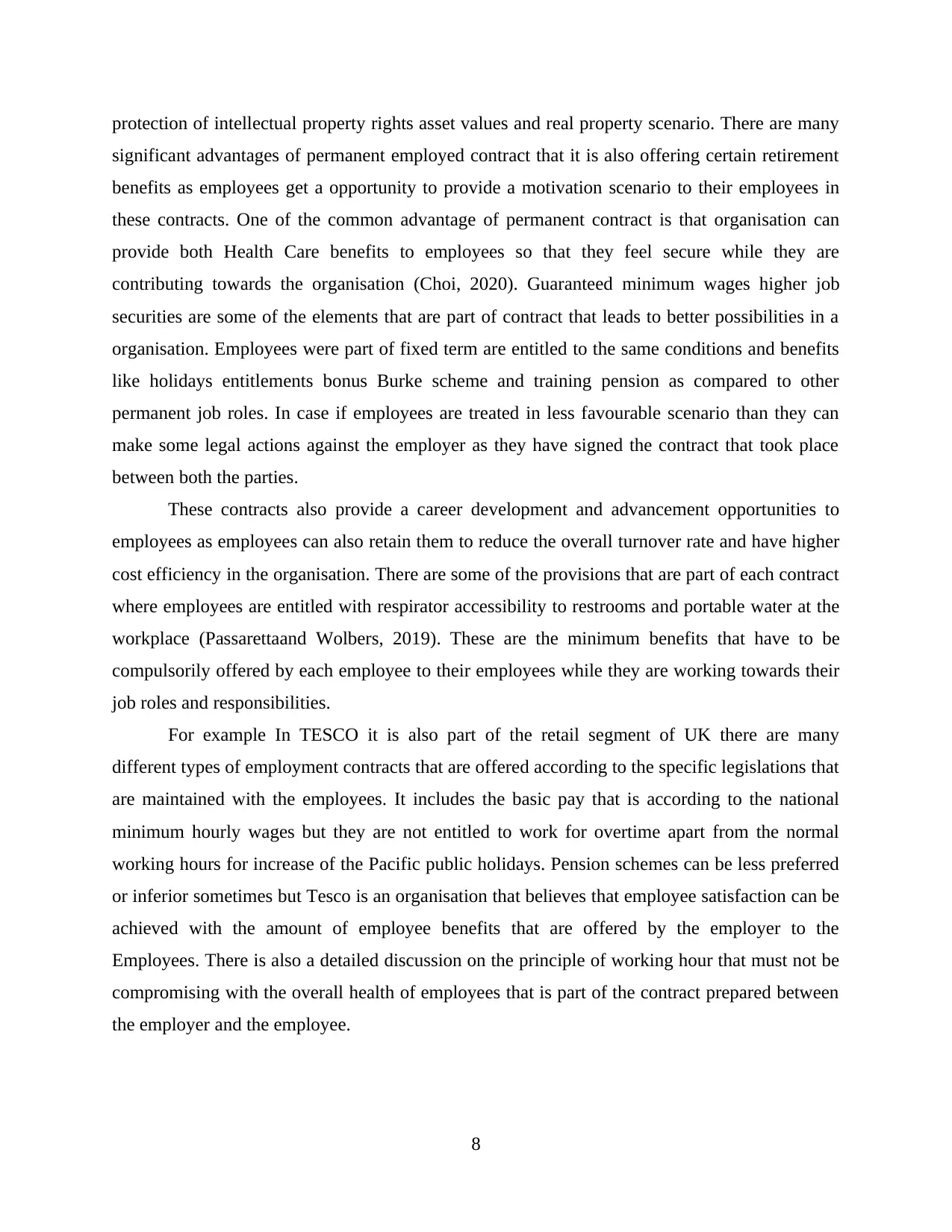
protection of intellectual property rights asset values and real property scenario. There are many
significant advantages of permanent employed contract that it is also offering certain retirement
benefits as employees get a opportunity to provide a motivation scenario to their employees in
these contracts. One of the common advantage of permanent contract is that organisation can
provide both Health Care benefits to employees so that they feel secure while they are
contributing towards the organisation (Choi, 2020). Guaranteed minimum wages higher job
securities are some of the elements that are part of contract that leads to better possibilities in a
organisation. Employees were part of fixed term are entitled to the same conditions and benefits
like holidays entitlements bonus Burke scheme and training pension as compared to other
permanent job roles. In case if employees are treated in less favourable scenario than they can
make some legal actions against the employer as they have signed the contract that took place
between both the parties.
These contracts also provide a career development and advancement opportunities to
employees as employees can also retain them to reduce the overall turnover rate and have higher
cost efficiency in the organisation. There are some of the provisions that are part of each contract
where employees are entitled with respirator accessibility to restrooms and portable water at the
workplace (Passarettaand Wolbers, 2019). These are the minimum benefits that have to be
compulsorily offered by each employee to their employees while they are working towards their
job roles and responsibilities.
For example In TESCO it is also part of the retail segment of UK there are many
different types of employment contracts that are offered according to the specific legislations that
are maintained with the employees. It includes the basic pay that is according to the national
minimum hourly wages but they are not entitled to work for overtime apart from the normal
working hours for increase of the Pacific public holidays. Pension schemes can be less preferred
or inferior sometimes but Tesco is an organisation that believes that employee satisfaction can be
achieved with the amount of employee benefits that are offered by the employer to the
Employees. There is also a detailed discussion on the principle of working hour that must not be
compromising with the overall health of employees that is part of the contract prepared between
the employer and the employee.
8
significant advantages of permanent employed contract that it is also offering certain retirement
benefits as employees get a opportunity to provide a motivation scenario to their employees in
these contracts. One of the common advantage of permanent contract is that organisation can
provide both Health Care benefits to employees so that they feel secure while they are
contributing towards the organisation (Choi, 2020). Guaranteed minimum wages higher job
securities are some of the elements that are part of contract that leads to better possibilities in a
organisation. Employees were part of fixed term are entitled to the same conditions and benefits
like holidays entitlements bonus Burke scheme and training pension as compared to other
permanent job roles. In case if employees are treated in less favourable scenario than they can
make some legal actions against the employer as they have signed the contract that took place
between both the parties.
These contracts also provide a career development and advancement opportunities to
employees as employees can also retain them to reduce the overall turnover rate and have higher
cost efficiency in the organisation. There are some of the provisions that are part of each contract
where employees are entitled with respirator accessibility to restrooms and portable water at the
workplace (Passarettaand Wolbers, 2019). These are the minimum benefits that have to be
compulsorily offered by each employee to their employees while they are working towards their
job roles and responsibilities.
For example In TESCO it is also part of the retail segment of UK there are many
different types of employment contracts that are offered according to the specific legislations that
are maintained with the employees. It includes the basic pay that is according to the national
minimum hourly wages but they are not entitled to work for overtime apart from the normal
working hours for increase of the Pacific public holidays. Pension schemes can be less preferred
or inferior sometimes but Tesco is an organisation that believes that employee satisfaction can be
achieved with the amount of employee benefits that are offered by the employer to the
Employees. There is also a detailed discussion on the principle of working hour that must not be
compromising with the overall health of employees that is part of the contract prepared between
the employer and the employee.
8
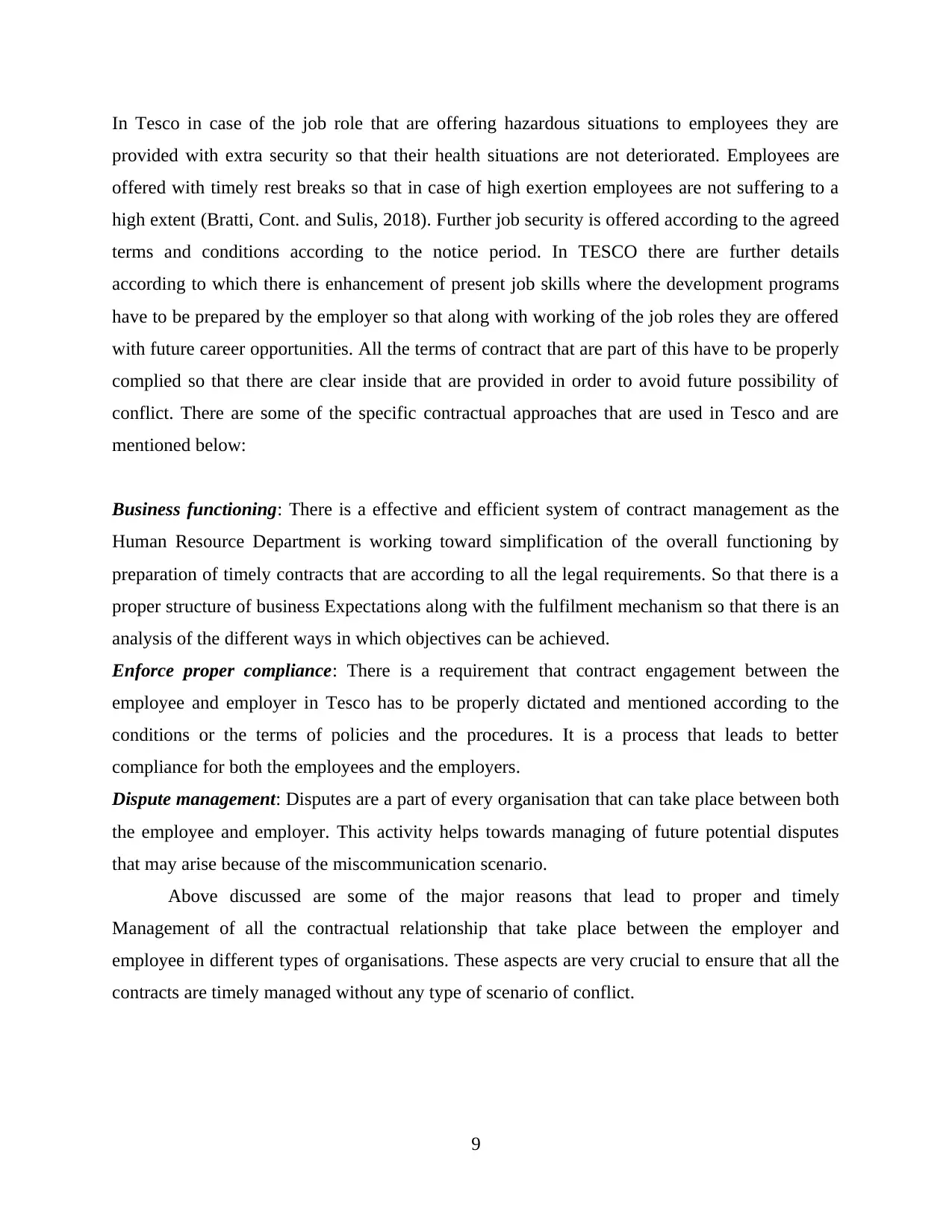
In Tesco in case of the job role that are offering hazardous situations to employees they are
provided with extra security so that their health situations are not deteriorated. Employees are
offered with timely rest breaks so that in case of high exertion employees are not suffering to a
high extent (Bratti, Cont. and Sulis, 2018). Further job security is offered according to the agreed
terms and conditions according to the notice period. In TESCO there are further details
according to which there is enhancement of present job skills where the development programs
have to be prepared by the employer so that along with working of the job roles they are offered
with future career opportunities. All the terms of contract that are part of this have to be properly
complied so that there are clear inside that are provided in order to avoid future possibility of
conflict. There are some of the specific contractual approaches that are used in Tesco and are
mentioned below:
Business functioning: There is a effective and efficient system of contract management as the
Human Resource Department is working toward simplification of the overall functioning by
preparation of timely contracts that are according to all the legal requirements. So that there is a
proper structure of business Expectations along with the fulfilment mechanism so that there is an
analysis of the different ways in which objectives can be achieved.
Enforce proper compliance: There is a requirement that contract engagement between the
employee and employer in Tesco has to be properly dictated and mentioned according to the
conditions or the terms of policies and the procedures. It is a process that leads to better
compliance for both the employees and the employers.
Dispute management: Disputes are a part of every organisation that can take place between both
the employee and employer. This activity helps towards managing of future potential disputes
that may arise because of the miscommunication scenario.
Above discussed are some of the major reasons that lead to proper and timely
Management of all the contractual relationship that take place between the employer and
employee in different types of organisations. These aspects are very crucial to ensure that all the
contracts are timely managed without any type of scenario of conflict.
9
provided with extra security so that their health situations are not deteriorated. Employees are
offered with timely rest breaks so that in case of high exertion employees are not suffering to a
high extent (Bratti, Cont. and Sulis, 2018). Further job security is offered according to the agreed
terms and conditions according to the notice period. In TESCO there are further details
according to which there is enhancement of present job skills where the development programs
have to be prepared by the employer so that along with working of the job roles they are offered
with future career opportunities. All the terms of contract that are part of this have to be properly
complied so that there are clear inside that are provided in order to avoid future possibility of
conflict. There are some of the specific contractual approaches that are used in Tesco and are
mentioned below:
Business functioning: There is a effective and efficient system of contract management as the
Human Resource Department is working toward simplification of the overall functioning by
preparation of timely contracts that are according to all the legal requirements. So that there is a
proper structure of business Expectations along with the fulfilment mechanism so that there is an
analysis of the different ways in which objectives can be achieved.
Enforce proper compliance: There is a requirement that contract engagement between the
employee and employer in Tesco has to be properly dictated and mentioned according to the
conditions or the terms of policies and the procedures. It is a process that leads to better
compliance for both the employees and the employers.
Dispute management: Disputes are a part of every organisation that can take place between both
the employee and employer. This activity helps towards managing of future potential disputes
that may arise because of the miscommunication scenario.
Above discussed are some of the major reasons that lead to proper and timely
Management of all the contractual relationship that take place between the employer and
employee in different types of organisations. These aspects are very crucial to ensure that all the
contracts are timely managed without any type of scenario of conflict.
9
⊘ This is a preview!⊘
Do you want full access?
Subscribe today to unlock all pages.

Trusted by 1+ million students worldwide
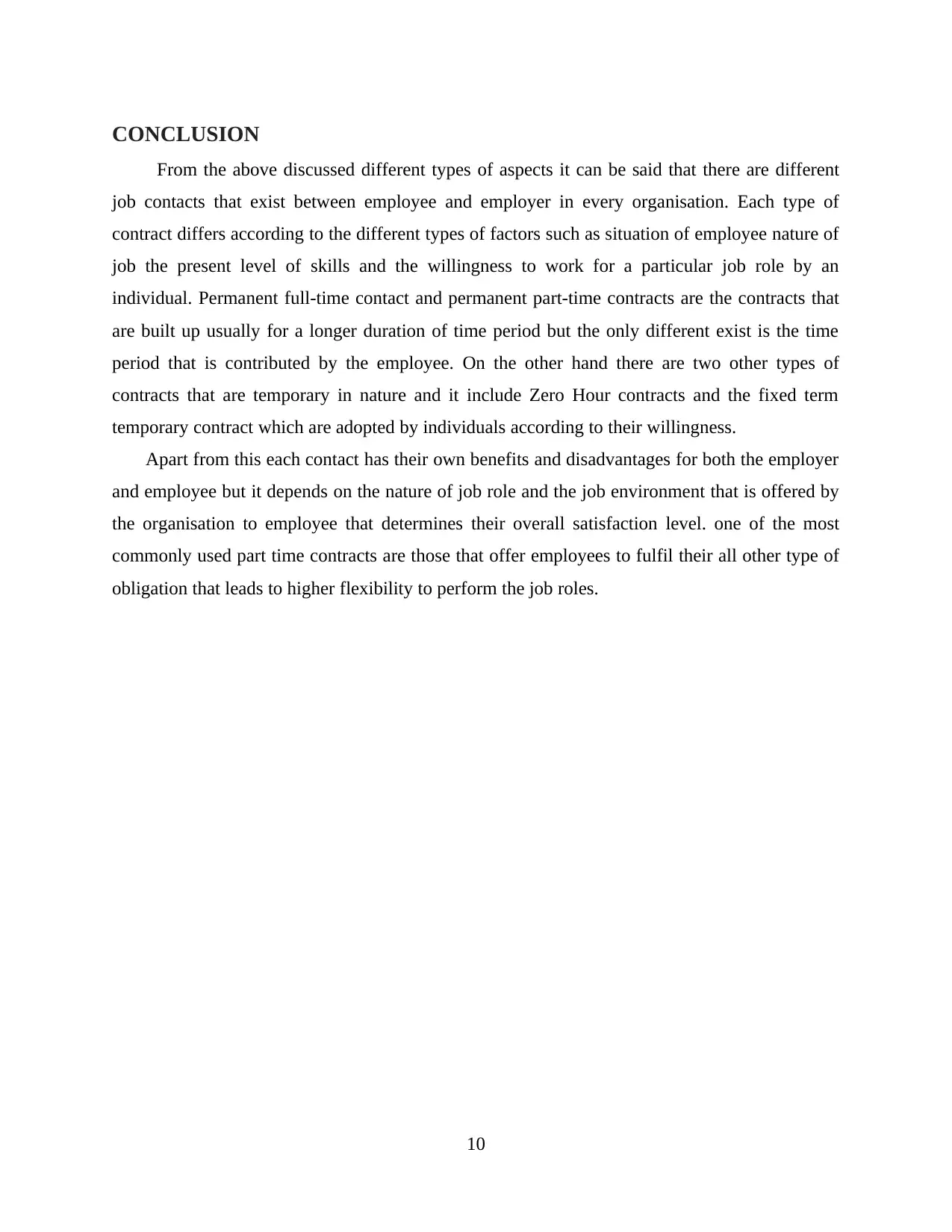
CONCLUSION
From the above discussed different types of aspects it can be said that there are different
job contacts that exist between employee and employer in every organisation. Each type of
contract differs according to the different types of factors such as situation of employee nature of
job the present level of skills and the willingness to work for a particular job role by an
individual. Permanent full-time contact and permanent part-time contracts are the contracts that
are built up usually for a longer duration of time period but the only different exist is the time
period that is contributed by the employee. On the other hand there are two other types of
contracts that are temporary in nature and it include Zero Hour contracts and the fixed term
temporary contract which are adopted by individuals according to their willingness.
Apart from this each contact has their own benefits and disadvantages for both the employer
and employee but it depends on the nature of job role and the job environment that is offered by
the organisation to employee that determines their overall satisfaction level. one of the most
commonly used part time contracts are those that offer employees to fulfil their all other type of
obligation that leads to higher flexibility to perform the job roles.
10
From the above discussed different types of aspects it can be said that there are different
job contacts that exist between employee and employer in every organisation. Each type of
contract differs according to the different types of factors such as situation of employee nature of
job the present level of skills and the willingness to work for a particular job role by an
individual. Permanent full-time contact and permanent part-time contracts are the contracts that
are built up usually for a longer duration of time period but the only different exist is the time
period that is contributed by the employee. On the other hand there are two other types of
contracts that are temporary in nature and it include Zero Hour contracts and the fixed term
temporary contract which are adopted by individuals according to their willingness.
Apart from this each contact has their own benefits and disadvantages for both the employer
and employee but it depends on the nature of job role and the job environment that is offered by
the organisation to employee that determines their overall satisfaction level. one of the most
commonly used part time contracts are those that offer employees to fulfil their all other type of
obligation that leads to higher flexibility to perform the job roles.
10
Paraphrase This Document
Need a fresh take? Get an instant paraphrase of this document with our AI Paraphraser
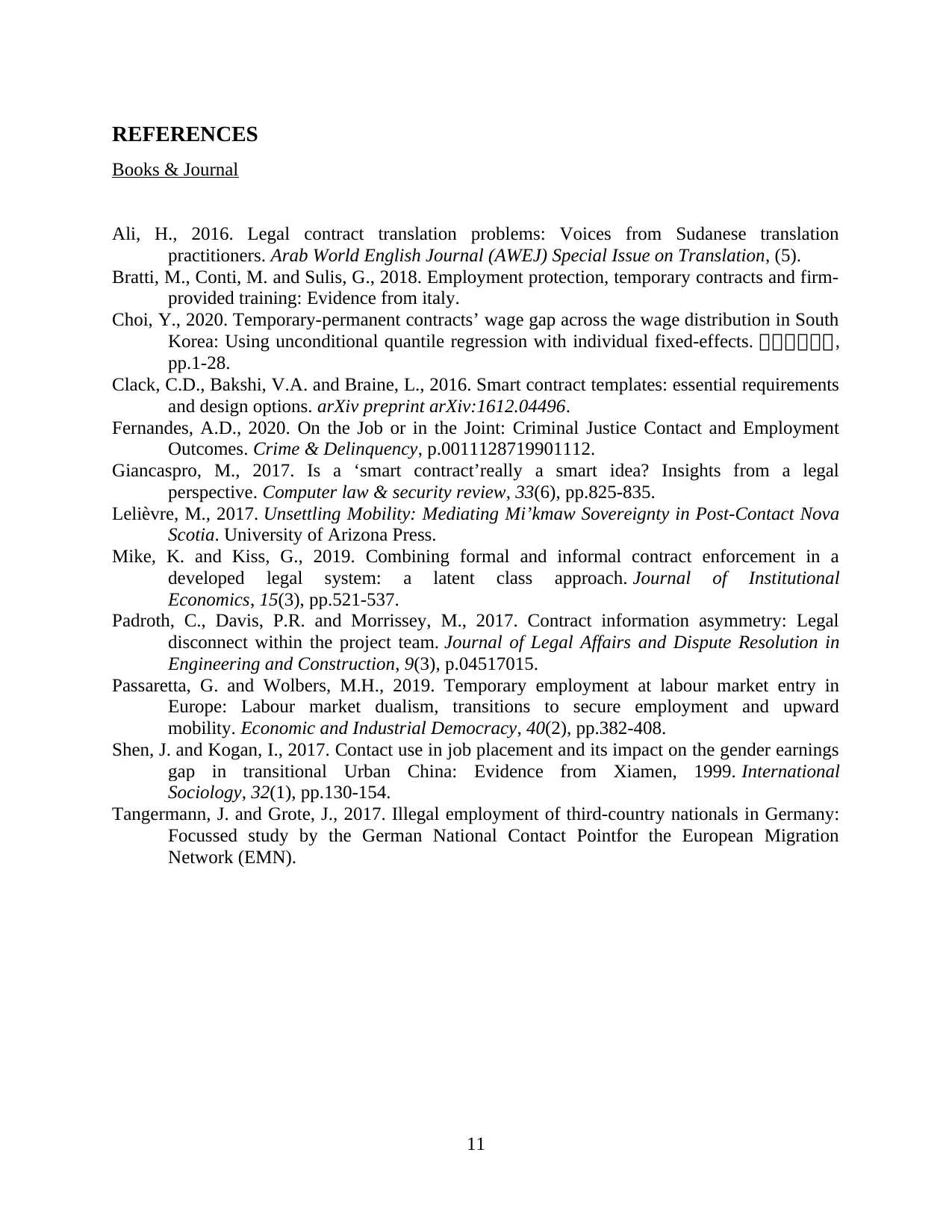
REFERENCES
Books & Journal
Ali, H., 2016. Legal contract translation problems: Voices from Sudanese translation
practitioners. Arab World English Journal (AWEJ) Special Issue on Translation, (5).
Bratti, M., Conti, M. and Sulis, G., 2018. Employment protection, temporary contracts and firm-
provided training: Evidence from italy.
Choi, Y., 2020. Temporary-permanent contracts’ wage gap across the wage distribution in South
Korea: Using unconditional quantile regression with individual fixed-effects. 노노노노노노,
pp.1-28.
Clack, C.D., Bakshi, V.A. and Braine, L., 2016. Smart contract templates: essential requirements
and design options. arXiv preprint arXiv:1612.04496.
Fernandes, A.D., 2020. On the Job or in the Joint: Criminal Justice Contact and Employment
Outcomes. Crime & Delinquency, p.0011128719901112.
Giancaspro, M., 2017. Is a ‘smart contract’really a smart idea? Insights from a legal
perspective. Computer law & security review, 33(6), pp.825-835.
Lelièvre, M., 2017. Unsettling Mobility: Mediating Mi’kmaw Sovereignty in Post-Contact Nova
Scotia. University of Arizona Press.
Mike, K. and Kiss, G., 2019. Combining formal and informal contract enforcement in a
developed legal system: a latent class approach. Journal of Institutional
Economics, 15(3), pp.521-537.
Padroth, C., Davis, P.R. and Morrissey, M., 2017. Contract information asymmetry: Legal
disconnect within the project team. Journal of Legal Affairs and Dispute Resolution in
Engineering and Construction, 9(3), p.04517015.
Passaretta, G. and Wolbers, M.H., 2019. Temporary employment at labour market entry in
Europe: Labour market dualism, transitions to secure employment and upward
mobility. Economic and Industrial Democracy, 40(2), pp.382-408.
Shen, J. and Kogan, I., 2017. Contact use in job placement and its impact on the gender earnings
gap in transitional Urban China: Evidence from Xiamen, 1999. International
Sociology, 32(1), pp.130-154.
Tangermann, J. and Grote, J., 2017. Illegal employment of third-country nationals in Germany:
Focussed study by the German National Contact Pointfor the European Migration
Network (EMN).
11
Books & Journal
Ali, H., 2016. Legal contract translation problems: Voices from Sudanese translation
practitioners. Arab World English Journal (AWEJ) Special Issue on Translation, (5).
Bratti, M., Conti, M. and Sulis, G., 2018. Employment protection, temporary contracts and firm-
provided training: Evidence from italy.
Choi, Y., 2020. Temporary-permanent contracts’ wage gap across the wage distribution in South
Korea: Using unconditional quantile regression with individual fixed-effects. 노노노노노노,
pp.1-28.
Clack, C.D., Bakshi, V.A. and Braine, L., 2016. Smart contract templates: essential requirements
and design options. arXiv preprint arXiv:1612.04496.
Fernandes, A.D., 2020. On the Job or in the Joint: Criminal Justice Contact and Employment
Outcomes. Crime & Delinquency, p.0011128719901112.
Giancaspro, M., 2017. Is a ‘smart contract’really a smart idea? Insights from a legal
perspective. Computer law & security review, 33(6), pp.825-835.
Lelièvre, M., 2017. Unsettling Mobility: Mediating Mi’kmaw Sovereignty in Post-Contact Nova
Scotia. University of Arizona Press.
Mike, K. and Kiss, G., 2019. Combining formal and informal contract enforcement in a
developed legal system: a latent class approach. Journal of Institutional
Economics, 15(3), pp.521-537.
Padroth, C., Davis, P.R. and Morrissey, M., 2017. Contract information asymmetry: Legal
disconnect within the project team. Journal of Legal Affairs and Dispute Resolution in
Engineering and Construction, 9(3), p.04517015.
Passaretta, G. and Wolbers, M.H., 2019. Temporary employment at labour market entry in
Europe: Labour market dualism, transitions to secure employment and upward
mobility. Economic and Industrial Democracy, 40(2), pp.382-408.
Shen, J. and Kogan, I., 2017. Contact use in job placement and its impact on the gender earnings
gap in transitional Urban China: Evidence from Xiamen, 1999. International
Sociology, 32(1), pp.130-154.
Tangermann, J. and Grote, J., 2017. Illegal employment of third-country nationals in Germany:
Focussed study by the German National Contact Pointfor the European Migration
Network (EMN).
11
1 out of 11
Related Documents
Your All-in-One AI-Powered Toolkit for Academic Success.
+13062052269
info@desklib.com
Available 24*7 on WhatsApp / Email
![[object Object]](/_next/static/media/star-bottom.7253800d.svg)
Unlock your academic potential
Copyright © 2020–2025 A2Z Services. All Rights Reserved. Developed and managed by ZUCOL.





